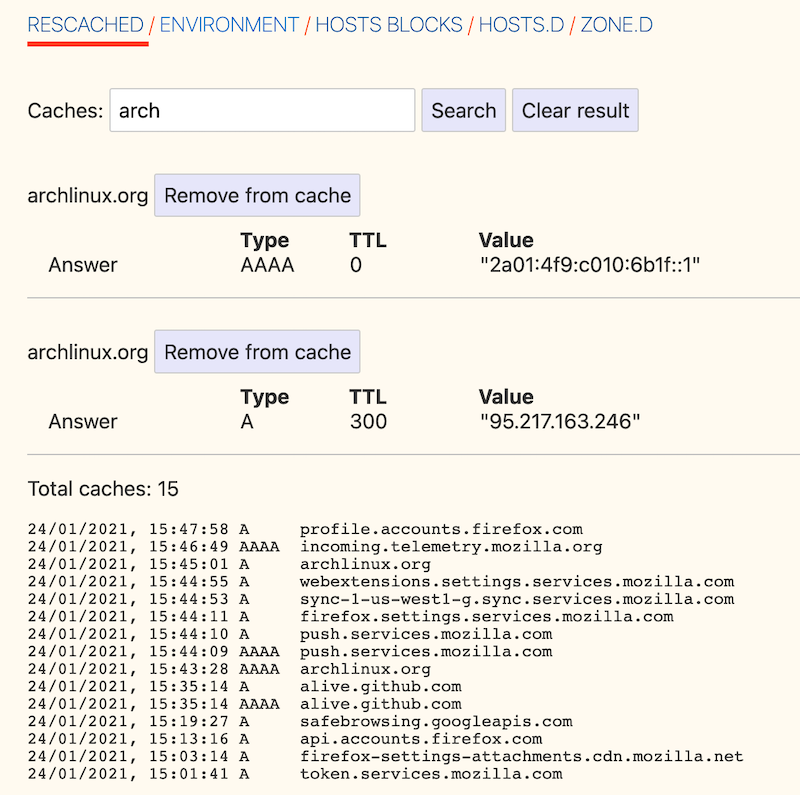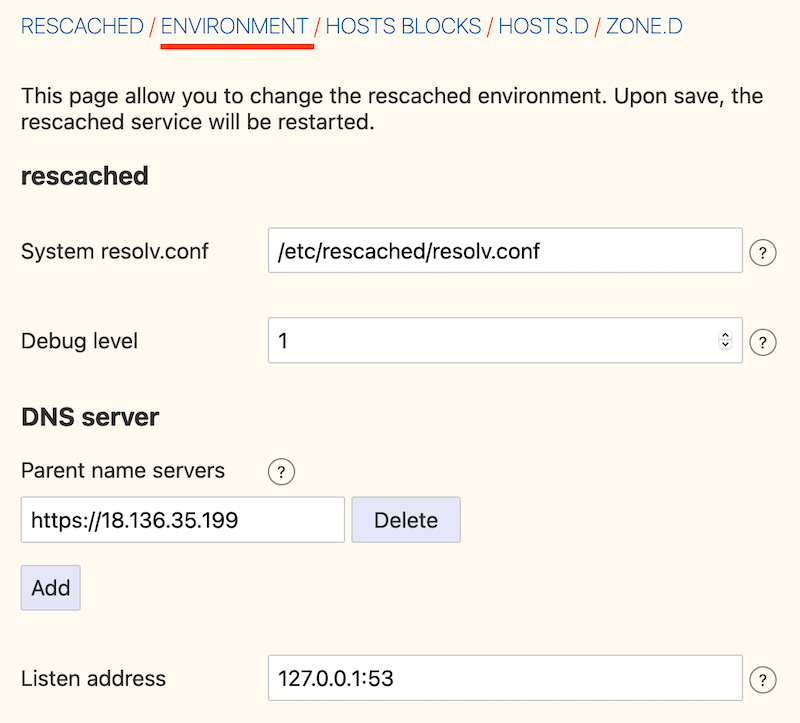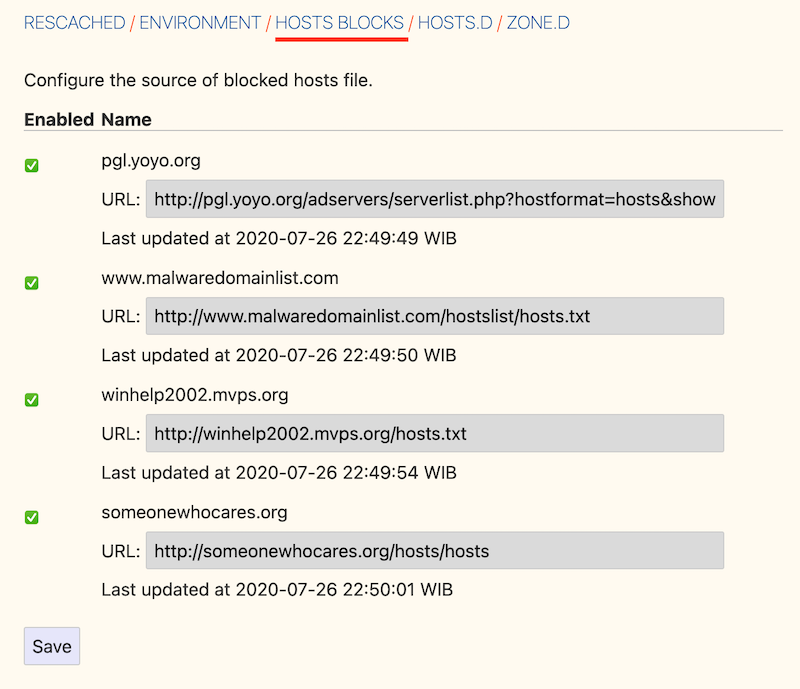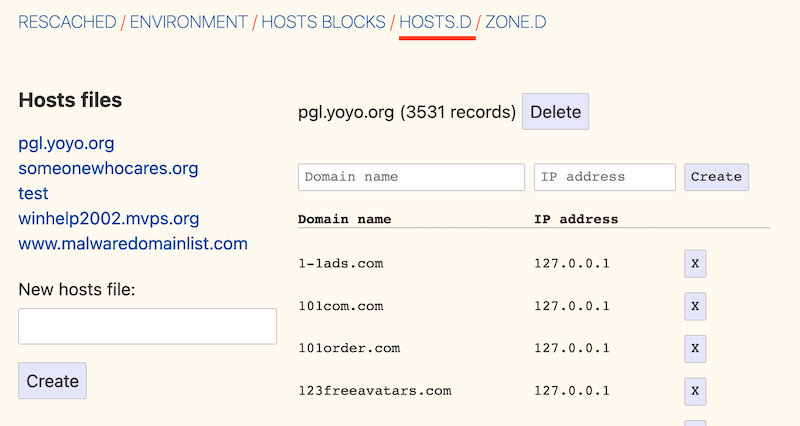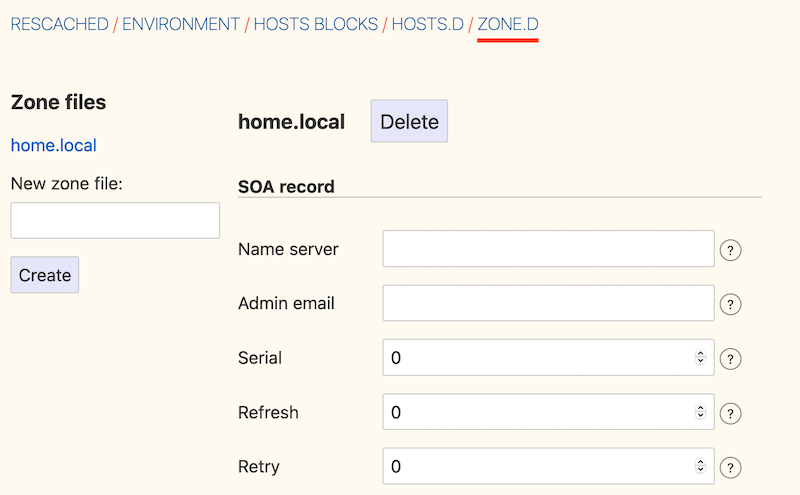rescached - DNS resolver cache daemon.
rescached.cfg is rescached configuration, usually it reside in
/etc/rescached/rescached.cfg.
rescached is a daemon that caching internet name and address on local memory
for speeding up DNS resolution.
rescached is not a reimplementation of DNS server like BIND.
rescached primary goal is only to caching DNS queries and answers, used by
personal or small group of users, to minimize unneeded traffic to outside
network.
List of current features,
-
Enable to handle request from UDP and TCP connections
-
Enable to forward request using UDP or TCP
-
Load and serve addresses and host names in
/etc/hosts -
Load and serve hosts formatted files inside directory
/etc/rescached/hosts.d/ -
Blocking ads and/or malicious websites through host list in
/etc/rescached/hosts.d/ -
Support loading and serving zone file format from
/etc/rescached/zone.d -
Integration with openresolv
-
Support DNS over TLS (DoH) (RFC 7858)
-
Support DNS over HTTPS (DoH) (RFC 8484)
When you open a website, let say 'kilabit.info', in a browser, the first thing that browser do is to translate name address 'kilabit.info' into an internet address (for example to 18.136.35.199) so browser can make a connection to 'kilabit.info' server.
How browser do that?
First, it will send query to one of DNS server listed in your system
configuration (for example, /etc/resolv.conf in Linux).
Then, if your DNS server also "caching" the name that you requested, it will
reply the answer (internet address) directly, if it is not then it will ask
their parent DNS server.
+----+ +----------------+ +------------------+ | PC | <==> | ISP DNS Server | <==> | Other DNS Server | <==> ... +----+ +----------------+ +------------------+
If you browsing frequently on the same site, hitting the refresh button, opening another page on the same website, etc; this procedures will always repeated every times, not including all external links like ads, social media button, or JavaScript from an other server.
To make this repetitive procedures less occurred, you can run rescached in
your personal computer.
The first time the answer is received in your local computer, rescached will
saved it in computer memory and any subsequent request of the same address
will be answered directly by rescached.
+----+ +----------------+ +------------------+ | PC | | ISP DNS Server | <==> | Other DNS Server | <==> ... +----+ +----------------+ +------------------+ ^^ ^^ || || vv || +-----------+ || | rescached | <==// +-----------+
The only request that will be send to your DNS server is the one that does not
already exist in rescached cache.
This section explain the simplified version of how internal program works.
Each DNS record in cache have the time last accessed field, which defined how the cache will be ordered in memory. The last queried host-name will be at the bottom of cache list, and the oldest queried host-name will at the top of cache list.
The following table illustrate list of caches in memory,
+---------------------+------------------+ | Accessed At | host-name | +---------------------+------------------+ | 2018-01-01 00:00:01 | kilabit.info | +---------------------+------------------+ | 2018-01-01 00:00:02 | www.google.com | +---------------------+------------------+ | ... | ... | +---------------------+------------------+ | 2018-01-01 00:01:00 | www.kilabit.info | +---------------------+------------------+
Every cache.prune_delay (let say every 5 minutes), rescached will try to
pruning old records from cache.
If the accessed-at value of record in cache is less than,
current-time + cache.threshold
(remember that "cache.threshold" value must be negative) it will remove the record from cache.
-
asciidoc, to generate manual pages
-
systemd or system V init tool for service on Linux
Steps to compile from source,
$ go get -u github.com/shuLhan/rescached-go
$ cd ${GOPATH}/src/github.com/shuLhan/rescached-go
$ go build ./cmd/rescached
The last command will build binary named rescached in current directory.
After program successfully build, you can install it manually by copying to system binary directory.
Copy rescached configuration to system directory. We use directory "/etc/rescached" as configuration directory.
$ sudo mkdir -p /etc/rescached $ sudo cp cmd/rescached/rescached.cfg /etc/rescached/
Copy rescached program to your system path.
$ sudo cp -f rescached /usr/bin/
Create system startup script.
If you want your program running each time the system is starting up you can
create a system startup script (or system service).
For OS using systemd, you can see an example for systemd service in
scripts/rescached.service.
For system using launchd (macOS), you can see an example in
scripts/info.kilabit.rescached.plist.
This step could be different between systems, consult your distribution wiki, forum, or mailing-list on how to create system startup script.
Automatic installation on Linux require systemd. Run the following command
$ sudo make install
to setup and copies all required files and binaries to system directories. You can then start the rescached service using systemd,
$ sudo systemctl start rescached
Run the following command
$ sudo make install-macos
to setup and copies all required files and binaries to system directories. You can then load the rescached service using launchd,
$ sudo launchctl load info.kilabit.rescached
-
Set your parent DNS server.
Edit rescached configuration,
/etc/rescached/rescached.cfg, change the value ofparentbased on your preferred DNS server. -
Set the cache prune delay and threshold
Edit rescached configuration,
/etc/rescached/rescached.cfg, change the value ofcache.prune_delayand/orcache.thresholdto match your needs. -
Set your system DNS server to point to rescached.
In UNIX system,
$ sudo mv /etc/resolv.conf /etc/resolv.conf.org $ sudo echo "nameserver 127.0.0.1" > /etc/resolv.conf
-
If you use
systemd, runrescachedservice by invoking,$ sudo systemctl start rescached.service
and if you want
rescachedservice to run when system startup, enable it by invoking,$ sudo systemctl enable rescached.service
All rescached configuration located in file /etc/rescached/rescached.cfg.
See manual page of rescached.cfg(5) for more information.
Rescached support loading zone file format.
Unlike hosts file format, where each domain name is only mapped to type A
(IPv4 address), in zone file, one can define other type that known to
rescached.
All files defined zone.d configuration are considered as zone file and
will be loaded by rescached only if the configuration is not empty.
Example of zone file,
$ORIGIN my-site.vm. $TTL 3600 ; resource record (RR) address @ A 192.168.56.10 ; resource record alias dev CNAME @ ; resource record address for other sub-domain staging A 192.168.100.1 ; resource record address for other absolute domain. my-site.com A 10.8.0.1
Here we defined the variable origin for root domain "my-site.vm." with minimum time-to-live (TTL) to 3600 seconds. If no "$ORIGIN" variable is defined, rescached will use the file name as $ORIGIN’s value.
The "@" character will be replaced with the value of $ORIGIN.
The first resource record (RR) is defining an IPv4 address for "my-site.vm." to "192.168.56.10".
The second RR add an alias for relative subdomain "dev". Domain name that does not terminated with "." are called relative, and the origin will be appended to form the absolute domain "dev.my-site.vm". In this case IP address for "dev.my-site.vm." is equal to "my-site.vm.".
The third RR define a mapping for another relative subdomain "staging.my-site.vm." to address "192.168.100.1".
The last RR define a mapping for absolute domain "my-site.com." to IP address "10.8.0.1".
For more information about format of zone file see RFC 1035 section 5.
Rescached can detect change on file generated by resolvconf. To use this feature unset the "file.resolvconf" in configuration file and set either "dnsmasq_resolv", "pdnsd_resolv", or "unbound_conf" in "/etc/resolvconf.conf" to point to file referenced in "file.resolvconf".
For more information see rescached.cfg(5).
DNS over HTTPS (DoH) is the new protocol to query DNS through HTTPS layer. Rescached support serving DNS over HTTPS or as client to parent DoH nameservers. To enable this feature rescached provided TLS certificate and private key.
Example configuration in rescached.cfg,
[dns "server"] parent = https://kilabit.info/dns-query tls.certificate = /etc/rescached/localhost.cert.pem tls.private_key = /etc/rescached/localhost.key.pem tls.allow_insecure = false
If the parent nameserver is using self-signed certificate, you can set "tls.allow_insecure" to true.
Using the above configuration, rescached will serve DoH queries on https://localhost/dns-query on port 443 and UDP queries on port 53. All queries to both locations will be forwarded to parent nameserver.
This feature can be tested using Firefox Nightly by updating the configuration in "about:config" into,
network.trr.bootstrapAddress;127.0.0.1 network.trr.mode;3 network.trr.uri;https://localhost/dns-query
Since we are using mode=3, the network.trr.bootstrapAddress is required so
Firefox Nightly can resolve "localhost" to "127.0.0.1".
If you use the provided self-signed certificate, you must import and/or enable
an exception for it manually in Firefox Nightly (for example. by opening
https://localhost/dns-query in new tab and accept security risk).
To check if DoH works, first, set the debug option to 1, and
restart the rescached.
Open a new terminal and run sudo journalctl -xf, to show current system log.
Run Firefox Nightly and open any random website.
At the terminal you will see output from rescached which looks like these,
... rescached[808]: dns: ^ DoH https://kilabit.info/dns-query 41269:&{Name:id.wikipedia.org Type:A}
... rescached[808]: dns: < UDP 45873:&{Name:id.wikipedia.org Type:AAAA}
... rescached[808]: dns: + UDP 41269:&{Name:id.wikipedia.org Type:A}
If you see number "4" in request line, "< request: 4", thats indicated that request is from HTTPS connection and its working.
The rescached service provide a web user interface that can be accessed at http://127.0.0.1:5380.
The front page allow user to monitor active caches, query the caches, and removing the caches.
The Environment page allow user to modify the rescached configuration on the fly.
The Hosts Blocks page allow user to enable or disable the external sources of hosts blocks list.
The Hosts.d page allow user to manage hosts file, creating new hosts file, create new record, or delete a record.
The Zone.d page allow user manage zone file, creating new zone file, adding or deleting new resource record in the zone file.
/etc/rescached/rescached.cfg-
The
rescachedmain configuration. This configuration will be read when program started. /usr/share/rescached/COPYING-
License file for this software.
/var/run/rescached.pid-
File where process ID of rescached will be saved when running.
This program developed with references to,
- RFC1034
-
Domain Names - Concepts and Facilities.
- RFC1035
-
Domain Names - Implementation and Specification.
- RFC1886
-
DNS Extensions to support IP version 6.
- RFC2782
-
A DNS RR for specifying the location of services (DNS SRV)
- RFC8484
-
DNS Queries over HTTPS (DoH)
rescached only know specific DNS record type,
| A |
A host address in IPv4 |
| NS |
An authoritative name server |
| CNAME |
A canonical name for an alias |
| SOA |
Start of [a zone of] authority record |
| MB |
Mail box |
| MG |
Mail group |
| NULL |
Placeholders for experimental extensions |
| WKS |
Record to describe well-known services supported by a host |
| PTR |
Pointer to a canonical name. |
| HINFO |
Host information |
| MINFO |
Mail information |
| MX |
Mail exchange |
| TXT |
Text record |
| AAAA |
A host address in IPv6 |
| SRV |
Service locator |
| OPT |
This is a "pseudo DNS record type" needed to support EDNS |
rescached only run and tested in Linux and macOS system.
Technically, if it can compiled, it will run in any operating system.
rescached is developed by Shulhan (ms@kilabit.info).
Copyright 2018, M. Shulhan (ms@kilabit.info). All rights reserved.
Use of this source code is governed by a GPL 3.0 license that can be found in the COPYING file.
The repository for this software is available at https://github.com/shuLhan/rescached-go.
For request of features and/or bugs report please submitted through web at https://github.com/shuLhan/rescached-go/issues.
